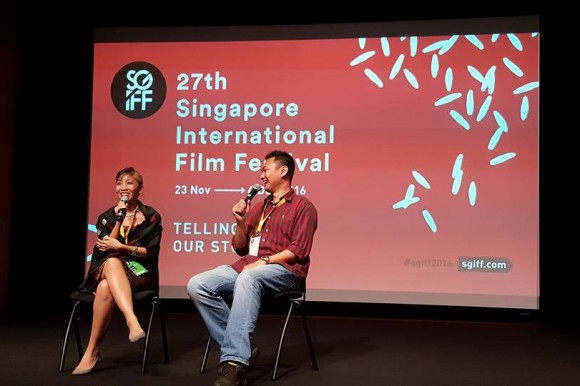28 Nov-4 Dec 2016 – SGIFF On The Ground Wrap Up
Masterclasses with auteurs Naomi Kawase, Herman Yau and Fruit Chan, films set in Laos as you’ve never seen before, and Silver Screen Award winner White Sun.

Ah, the ending of the festival. As I write this we are already a day past Sunday 4th Dec, and I am barely awake from a much-needed 12 hour rest. Yesterday the Silver Screen Award winners White Sun and In The Year Of Monkey (which won Best Asian Feature Film and Best Southeast Asian Short Film) screened at the National Museum of Singapore, and it was a perfect catch-up opportunity to see these visions on the big screen. White Sun director Deepak Rauniyar’s story of a man’s unwelcome return to the village to give his recently deceased father a proper burial was quietly touching, and lead actor Dayahang Rai (who was in attendance at the Festival) gives an impassioned performance as a man who endeavours to do right by his family. However, it is the kids’ performances in the film that really give this film gravitas, and I just thought it was incredible that director Rauniyar managed to coax such strong performances from his child actors. The ending brought the film full circle, and I thought it to be simply luminous. White Sun is a deserving winner of our Best Asian Feature Film award, and I will be keeping an eye out for more Nepalese cinema in future.

But it isn’t just Nepalese cinema that is deserving of the spotlight. Earlier that week, I had the great privilege and pleasure to host Laotian director Mattie Do (who incidentally co-produced Bangkok Nites, another selection at the Festival) at the Asian premiere of her amazing film Dearest Sister. This wonderful gem really struck a chord with me simply because of its really accomplished use of supernatural genre elements to highlight its bigger social themes of class, privilege and above all, family ties. Usually most Asian horror films simply use the horror as a means to itself – think Shutter or The Ring – but Dearest Sister took me by surprise because it was not only a really creepy film, with professionally done SFX, but its observation of wider themes displayed much intelligence and sensitivity. I’d like to say the last film that took me by such pleasant surprise was Let The Right One In, the 2008 Swedish horror film that used genre elements to highlight bigger human themes.

I was understandably gushing on stage while moderating the Q&A with Mattie, whom is probably the humblest director I’ve met. Whilst I complimented her on her good grasp of film grammar with such fluid editing and seamless performances, she claimed that her only film education was by watching old horror movies as a kid. Mattie also shared some hilarious anecdotes – one involving her dogs which had refused to leave her set, which led to the crew having to cover them with blankets and pillows so they would not ruin the shot.

The second week of the Festival also saw more well-known directors Naomi Kawase, Herman Yau and Fruit Chan give Masterclasses. It was quite apparent to me that each director had very specific preoccupations – Kawase was informed by her early experiences making documentary films, which affected her aesthetic even in her fiction works. Concerned with the relationship between fiction and reality, she showed clips from her early films to illustrate her point about the importance of framing, and using the camera to denote perspectives and relations between characters.

Director Herman Yau however, displayed his rebellious streak by proudly proclaiming his latest work The Mobfathers, which had a screening the night before at Shaw Theatres Lido, as unacceptable in mainland China. He said that sex scenes, triad violence and even star Chapman To himself were issues that hindered the film’s release in China, and so he decided to go the full monty on these elements. And it showed – I was there at the Lido screening the night before and these pulp elements really jumped off the screen in lurid abandon. Herman went on to comment about the prolific output of his works, saying that he would find making the same police stories over and over again “too boring”, which is why his works run the gamut of genres. The audience was absolutely riveted by his devil-could-care-less comments.

If Herman was the rebel, the masterclass with Fruit Chan really cemented his fellow Hong Kong counterpart’s desire for independence. Throughout Fruit’s masterclass, he delved into his struggles making films with little-to-no budget, his proletariat upbringing on cinema (Fruit was a film projectionist when he was a student, screening the same film 7-8 times a single day. He soon became adept at picking out the good and bad of films, which informed his own path as a film director), but above all, how films must be entertaining, which he felt was often missing from modern films. He emphasised how even if one were to be fully independent, one had to balance the commercial side of making indie films, since “it is very difficult to earn a living if you want to be completely indie.”

If all this seemed like an overwhelming deluge of information in just 12 short days, it kinda is. But for cinephiles and filmmakers from around the region – what a time to be alive. What other cultural event in Singapore’s calendar could possibly provide so much nourishment for our cinema-centric soul? Through all the madness and sleep-deprived days, I could barely scratch the surface, or see even half of the 161 films on tap at the Festival. But I wouldn’t have it any other way. Here’s to the successful end of the 27th edition of the Singapore International Film Festival! I can’t wait to see what the 28th edition has in store for us.


